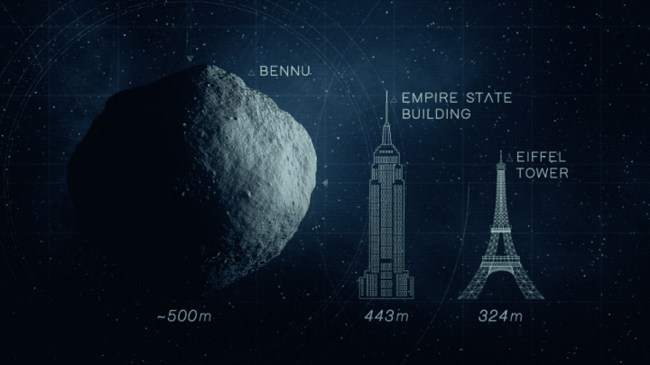Scientists recently completed computer simulations of what would happen to Earth if it were impacted by an asteroid with a diameter the size of the 500-meter-wide Bennu. It’s not good.
Why Bennu? Well, astronomers have predicted that asteroid Bennu, which is about one-third of a mile wide at its equator, has a one-in-2,700 chance (0.037%) of hitting Earth in the year 2182.
Bennu was also the target of NASA’s OSIRIS-REx, the first U.S. mission to collect a sample from an asteroid and deliver it to Earth in 2023. It was chosen for this mission because it makes a close approach to Earth (coming within about 186,000 miles or about 53,000 miles closer than our moon) every six years.
As for the results of the simulations conducted by the researchers at the IBS Center for Climate Physics (ICCP) at Pusan National University in South Korea, should Bennu strike our planet it would “inject up to 400 million tons of dust into the stratosphere, show marked disruptions in climate, atmospheric chemistry, and global photosynthesis.
“Global mean temperatures are projected to drop by 4°C [7°F], and global precipitation decreases by 15% in our simulations. The largest relative reductions in global terrestrial and marine net primary productivity reach 36 and 25%, respectively.
“Depending on the iron amount of the asteroid and the subsequent marine dust deposition, large diatom blooms occur in iron-limited regions such as the Southern Ocean and the eastern equatorial Pacific.”
But wait, there’s more.
A collision between asteroid Bennu and Earth would also trigger thermal radiation, earthquakes, tsunamis, and other, more long-lasting climatic effects by emitting large quantities of aerosols and gases into the atmosphere.
“The solar dimming due to dust would cause an abrupt global ‘impact winter’ characterized by reduced sunlight, cold temperature and decreased precipitation at the surface,” said the study’s lead author Lan Dai, a postdoctoral research fellow at the IBS Center for Climate Physics at Pusan National University.
As for how many people an asteroid impact of that size would kill, Dai says that “mainly depends on where the asteroid impact occurs.”
Of more urgent concern, however, is asteroid 2024 YR4, which has a 1.2% chance of slamming into Earth in 2032. It has the highest impact probability of any large asteroids currently known by NASA. This is especially concerning because at this point in time, we really don’t have any way to stop it.
And don’t even get us started on the 67.24 million ton “Colossal God of Chaos” asteroid which is expected to fly within less than 20,000 miles of Earth’s surface (closer than most satellites in Earth’s orbit) in the year 2029.

